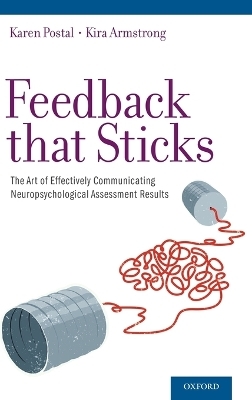
Feedback that Sticks
Oxford University Press Inc (Verlag)
978-0-19-976569-0 (ISBN)
This book is about how to give outstanding feedback to patients, their family members, and other professionals. Effective feedback sessions have the potential to help patients understand their neurocognitive syndromes in the larger context of their real world environments and in a manner that positively alters lives.
As our profession has matured, feedback sessions with patients and family members have become the norm rather than the exception. Nonetheless, many senior and even mid-career neuropsychologists were never explicitly taught how to give feedback. And despite the burgeoning neuropsychological literature describing sophisticated assessment methods and neuropsychological syndromes, there has been almost no parallel literature describing techniques for communicating this information to patients and other professionals. This begs the question: how have we learned to do this extraordinary task well? And how do we effectively communicate intrinsically complex assessment results, to deliver the type of salient feedback that alters lives? It turns out, the answers are like feedback sessions themselves - varied and complex.
Feedback that Sticks presents a compilation of the clinical feedback strategies of over 85 neuropsychologists from all over the country: training directors, members of tertiary medical teams, and private practitioners. It offers the reader the ability to be a fly on the wall as these seasoned neuropsychologists share feedback strategies they use with patients across the lifespan, and who present with a wide variety of neurological and developmental conditions. Like receiving the best feedback training from 85 different mentors, the book gathers the most compelling, accessible ways of explaining complex neuropsychological concepts from a broad variety of practitioners. Through this process, it offers a unique opportunity for practicing neuropsychologists to develop, broaden, and strengthen their own approaches to feedback.
Karen Postal is a board certified neuropsychologist. She is the president of the Massachusetts Neuropsychological Society, the immediate past president of the Massachusetts Psychological Association, and a member of the board of directors of the American Academy of Clinical Neuropsychology. Kira Postal is a lecturer at Harvard Medical school where she teachers postdoctoral fellows in neuropsychology. Her practice is dedicated to helping people think better in school, at work, and throughout later life. Dr. Armstrong is a board certified neuropsychologist currently working in private practice with an emphasis on pediatrics. Dr. Armstrong previously served as the secretary for the Massachusetts Neuropsychological Society and is currently a member of the board of directors of the American Academy of Clinical Neuropsychology.
Table of Contents ; Contributors ; Prologue ; Part I: What is feedback, and what makes it stick? ; Chapter 1: Feedback that Sticks: The art of communicating neuropsychological assessment results ; Chapter 2: Why some feedback sticks ; Chapter 3: Feedback protocols and theoretical considerations ; Chapter 4: How is feedback presented? ; Part II: Putting Feedback to Work ; Chapter 5: Putting feedback to work with patients from multiple populations ; Developing relationships with patients and families ; Connecting with the patient family ; Creating a therapeutic atmosphere for parents and caretakers ; Setting the stage for feedback ; Explaining the testing process and goals ; Explaining the normal curve ; Acknowledging the limitations of testing ; Offering hope and normalizing findings ; Explaining memory ; Pearls to explain slowed/inefficient processing ; Explaining executive function and frontal impairment ; Offering recommendations and compensatory strategies ; Introducing compensatory strategies for memory ; Recommending psychotherapy ; Pearls to facilitate connecting with other cultures ; Introducing religious ideas ; Offering feedback to pilots ; General pearls for the pediatric population ; Parting words ; Chapter 6: Dementia ; Discussing dementia and memory loss with families and patients ; Mild cognitive impairment ; Using the "A" word - Alzheimer disease ; Caregiver issues ; Helping caregivers to understand and manage their loved one's deficits ; Encouraging caregivers to take care of themselves - and to share the burden among family members ; Addressing unawareness with patients ; Caregiver unawareness/denial ; Driving ; Securing services in the home and transitioning to assisted living or nursing home placement ; Helping patients and caregivers accept and implement compensatory strategies ; Visual hallucinations and Capgrass ; Legal issues ; Chapter 7: Attention Deficit Hyperactivity Disorder ; Defining attention problems ; Explaining the difference between can't vs. won't ; Executive functions ; Treatment issues ; Anxiety and ADHD ; Behavioral interventions / compensatory strategies ; Accepting the Diagnosis ; Explaining the diagnostic process ; Chapter 8: Somatoform Disorders ; Developing empathy as a provider ; Acknowledging the patient's symptoms ; Introducing other factors, such as role strain, that affect cognitive efficiency ; Discussing the meaning of normal test results while maintaining a therapeutic relationship ; Introducing the role of stress and emotions ; Introducing interventions ; Framing an unknowable medical issue ; Normalizing somatization ; Creating an "out" ; Chapter 9: Psychiatric Illness ; Explaining schizophrenia and other psychiatric disease ; Addressing resistance to feedback ; Coping with delusions and hallucinations ; Discussing treatment interventions ; Substance abuse ; Uncertain psychiatric diagnosis ; Chapter 10: Learning Disorders and Developmental Disability ; Disclosing IQ ; Intellectual disability (MR) ; Discussing the meaning of MR or Intellectual Disability ; Correcting misunderstandings about a child's ability level ; Sexuality ; Long term planning for severely impaired children ; Learning Disabilities ; Explaining Dyslexia and Language Disorders ; Using specific test performances to explain daily difficulties ; Using Labels ; Will my child be able to go to college? ; Accommodations ; Securing special education services (IEP's) ; The comorbidity of anxiety disorders, ADHD, and learning disorders ; Chapter 11: Autistic Spectrum Disorders ; Explaining Autism Spectrum Disorders and associated difficulties ; Sharing an Autism diagnosis with parents ; Discussing long-term expectations and prognosis ; Recommendations and Interventions ; Alternative treatments ; Long term planning for autistic children ; Issues specific to adults with Autistic spectrum disorders ; Chapter 12: Acquired Brain Injury: Traumatic Brain Injury and CVA ; Discussing prognosis and expectations for recovery ; Creating realistic expectations for treatment and longer-term goals ; Offering Hope ; Unawareness following acquired brain injury ; Return to work/ School ; How to encourage compensatory strategies and active rehabilitation ; Emotional issues with acquired brain injury recovery ; Explaining specific neurological, cognitive and behavioral sequelae of CVA ; Aphasias ; Explaining specific neurological, cognitive and behavioral sequelae of moderate and severe TBI ; Mild traumatic brain injury ; Athletes and MTBI ; Chapter 13: Neurological Disorders ; Cancer ; Genetic Disorders ; Sickle cell anemia ; Neurofibromatosis ; Seizures and epilepsy ; Nonepileptic Seizures/Pseudoseizures ; Epilepsy surgery ; Prematurity ; Hydrocephalus ; Spina Bifida ; Cerebral Palsy ; Multiple Sclerosis ; Hepatitis ; HIV ; Chapter 14: Addressing Effort ; Timing of feedback regarding suboptimal effort ; Addressing suboptimal effort with patients during the assessment ; Learning disability populations ; Part III: Communcation Beyond the Feedback Session ; Chapter 15: Communicating assessment results with other professionals ; Chapter 16: Report writing and written communication ; Epilogue ; Author Index ; Subject Index
| Verlagsort | New York |
|---|---|
| Sprache | englisch |
| Maße | 161 x 242 mm |
| Gewicht | 576 g |
| Themenwelt | Geisteswissenschaften ► Psychologie ► Arbeits- und Organisationspsychologie |
| Geisteswissenschaften ► Psychologie ► Biopsychologie / Neurowissenschaften | |
| Geisteswissenschaften ► Psychologie ► Klinische Psychologie | |
| Medizin / Pharmazie ► Medizinische Fachgebiete ► Neurologie | |
| ISBN-10 | 0-19-976569-3 / 0199765693 |
| ISBN-13 | 978-0-19-976569-0 / 9780199765690 |
| Zustand | Neuware |
| Haben Sie eine Frage zum Produkt? |
aus dem Bereich


